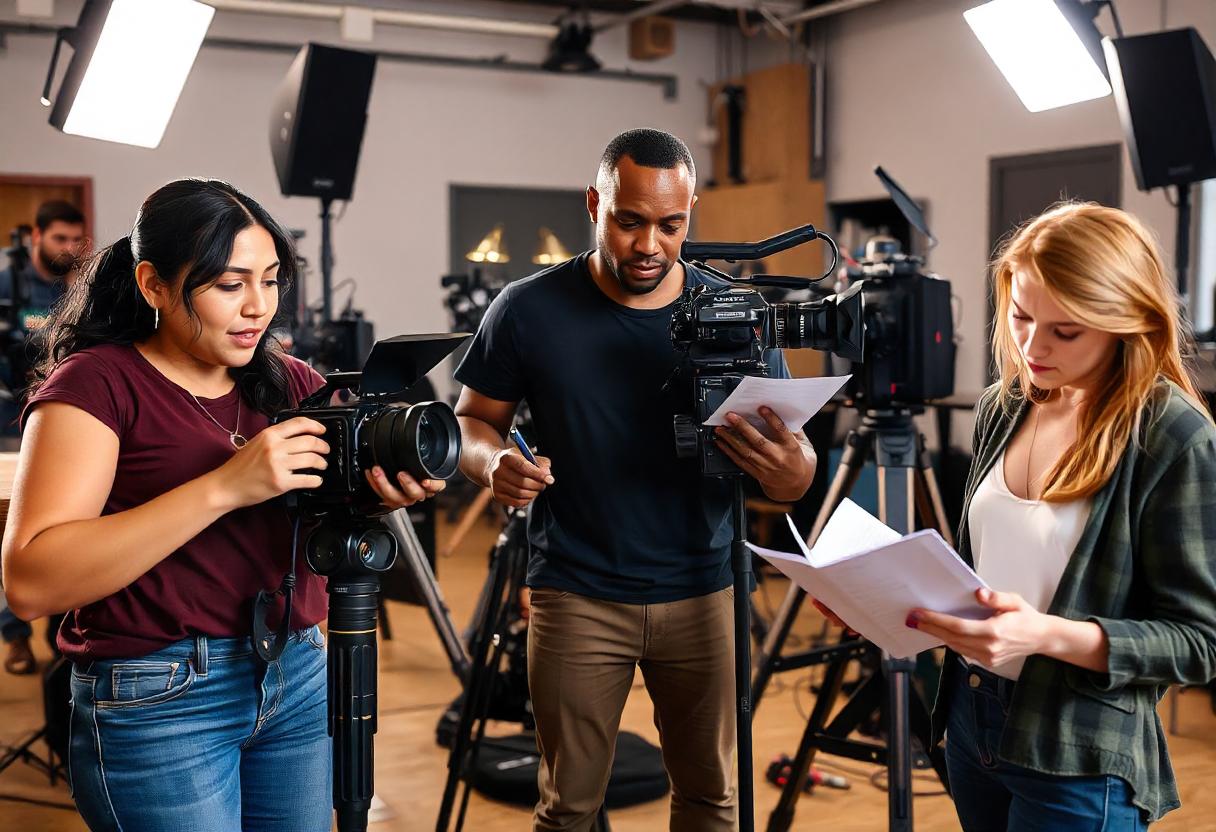The 5 C’s of Cinematography: Secrets to Visual Storytelling
Are you passionate about becoming a Cinematographer? If so, pursuing a B.Sc in Cinema (Specialization in Cinematography) right after completing your schooling is a great step.
Enrolling in these Cinematography Courses at a top Indian college, like AAFT, will equip you with all the skills and knowledge needed to propagate this landscape of film-making.
In this blog, we will discuss what are the 5 C’s of Cinematography. We will also discuss the ways to apply these to your practice and the common mistakes to avoid. Let’s begin right away!
The 5 C’s of Cinematography
The five C’s of cinematography, as outlined by Joseph V. Mascelli in his book “The Five C’s of Cinematography: Motion Picture Filming Techniques,” represent essential film-making concepts and techniques. These five C’s include camera angles, continuity, cutting, close-ups, and composition. Let’s discuss those in detail below:
1. Camera Angles
Do you want free career counseling?
Ignite Your Ambitions- Seize the Opportunity for a Free Career Counseling Session.
- 30+ Years in Education
- 250+ Faculties
- 30K+ Alumni Network
- 10th in World Ranking
- 1000+ Celebrity
- 120+ Countries Students Enrolled
Camera Angles refers to the camera position while filming. Different angles can influence the narrative significance of a scene. For example, a low-angle shot makes the subject appear larger and more dominant, as seen with Darth Vader.
Read Also: Mastering Post-Production: Tips and Techniques for Beginners
On the other hand, a high-angle shot makes the subject appear smaller and more vulnerable, as exemplified in Alfred Hitchcock’s “Psycho.” These angles can evoke specific emotions and highlight the dynamics of power between characters, adding depth to the storytelling.
Book Now →
2. Continuity
Continuity ensures that scenes are well interconnected and flow well to present a fluid sequence of events. This is achieved through careful shooting and editing.
A prime example of Continuity is the tracking shot in “Goodfellas.” The film immerses the viewer in the world of the characters, demonstrating the narrative power of continuity. Directors like Paul Thomas Anderson and Alfonso Cuarón have also used these and similar other techniques to create seamless and immersive storytelling experiences to elevate the engagement of the viewers.
3. Cutting
Cutting involves editing scenes to create a cohesive and engaging narrative. The technique helps in maintaining optimal continuity or disorient the viewer with techniques like jump cuts.
Do you want free career counseling?
Ignite Your Ambitions- Seize the Opportunity for a Free Career Counseling Session.The French New Wave often used jump cuts to challenge traditional storytelling, as seen in the film “Oldboy.” This brilliant movie used non-linear presentation to reflect the experience of the character.
4. Close-ups
Close-ups primarily focus on the face of the subject while drawing attention to their emotions and motivations. This technique is used effectively in the “Joan of Arc”, the film released way back in 1928, to convey deep emotional states.
Read Also: From Script to Screen: The Role of a Director in Filmmaking
Close-ups are invaluable for showing rather than telling the audience the character’s feelings. They can create an intimate viewer and character connection, making the audience more invested in the narrative and the character’s journey.
5. Composition
Composition refers to the actors arrangement and props within the view of the camera. It can include various shots like wide shots, mid shots, and over-the-shoulder shots.
A notable example of composition is the deep focus application in the movie “Citizen Kane,” released in 1941, where both the foreground and background were kept in focus. This approach boosts the visual storytelling and thematic depth of the scene.
The thoughtful composition can guide the viewer’s eye and emphasize important elements within the frame, contributing to the overall aesthetic and meaning of the film.
Tips for Applying the 5 C’s in Your Cinematic Projects
If you’re aiming for perfect cinematography after completing your Cinematography Courses in your projects, these five C’s will be extremely beneficial. Here are some tips to help you apply these fundamental techniques effectively:
Read Also: How to Build a Career in Film Direction: Guide for Beginners
- Camera Angles: Try toexperiment with different angles of the camera to influence the narrative significance of your scenes. A low-angle shot can make your subject more dominant and powerful. In contrast, a high-angle shot can make them seem vulnerable.
- Continuity: You need to ensure the seamless flow of your scene to create a fluid sequence of events. This approach involves careful planning, shooting, and precise editing of the scenes. For this, techniques like shot tracking can help immerse your audience in the story, making them feel like they are part of the action.
- Cutting: Utilize the applications of cutting to create a narrative that is both cohesive and engaging. Whether you are maintaining continuity or using jump cuts to disorient the viewer, effective editing can easily manipulate time and space effectively. This further enhances the emotional impact of your story.
- Close-ups: Utilize close-ups to draw attention to the emotions and motivations of your character. This technique allows you to show rather than tell what a character is feeling, creating an intimate viewer and the character’s connection. Moreover, they can make the audience more invested in the narrative and the character’s journey.
- Composition: Pay careful attention to the actors and props arrangement within the frame. Use various types of shots like wide shots, mid shots, and over-the-shoulder shots to guide the viewer’s eyes and emphasize critical elements.
- Lighting: Use lighting to set the scene’s mood and tone. Deep shadows can create a mystery sense, soft lights can evoke peace and harmony, while a high-contrast lighting can amplify tension. These right lighting choices can impact the emotional film’s atmosphere significantly.
- Visual Storytelling: Always remember that cinematography is about more than just shot capturing. You must set design, camera angles, and framing to visually tell your story. A well-crafted shot can convey the emotions of the character and the significance of objects within the scene.
- Genre-Specific Techniques: Tailor your cinematography techniques to fit your film genre. For example, dark and unsettling imagery works well for horror movies, while soft and inviting lighting suits romantic or comedy films. The right visual style helps set audience expectations and enhances the overall experience.
Common Mistakes to Avoid When Applying The 5Cs
Film-making is a complex process which requires meticulous attention in every aspect, ranging from pre-production to post-production. Applying these 5Cs can significantly elevate your cinematography skills. However, there are certain common pitfalls to avoid during the process, as per the Best Acting School In India, described below:
1. Concept
Mistake: Jumping into production without a clear vision or storyboard.
Advice: Ensure every scene aligns with your film’s overarching theme and emotional tone. Plan your shots with storyboarding tools and involve your team in pre-production discussions.
Example: Highlight how successful filmmakers develop detailed concepts before shooting.
Read Also: Cinematography vs. Film Direction: Key Differences & Similarities
2. Composition
Mistake: Over-reliance on flashy angles or extreme framing techniques.
Advice: Emphasize simplicity and balance in your frames. Study classic painters and photographers for inspiration on spatial arrangement.
Example: Mention a director who has completed their Cinematography Course from the best Film Institute and uses subtle yet powerful framing to evoke emotion, such as in intimate scenes.
3. Camera Movement
Mistake: Overusing dynamic camera moves like zooms or pans without purpose.
Advice: Use movement to enhance storytelling. Consider whether a stationary shot might be more impactful for a particular scene.
Example: Analyze a well-known scene that uses minimal movement to heighten tension or drama.
4. Color
Mistake: Ignoring color grading until post-production.
Advice: Plan a cohesive color palette during pre-production that aligns with your story’s mood. Test lighting setups to see how they affect the colors in-camera.
Example: Reference filmmakers who use distinct palettes to define their visual style, like Wes Anderson or Guillermo del Toro.
Read Also: The Impact of Technology on Education in Classrooms
5. Cutting (Editing)
Mistake: Relying on editing to fix poor footage or missing sequences.
Advice: Capture enough varied footage on set to ensure flexibility during editing. Maintain a rhythm that suits the narrative.
Example: Share an anecdote about a film where editing transformed a chaotic shoot into a cohesive masterpiece.
Final Thoughts!
So, there you have it: the five C’s of Cinematography. Each “C” is crucial to film-making. Together, they are invaluable in displaying the camera’s role in storytelling.
In a single liner, if we need to describe this, “The camera is to film what the brush and canvas are to art.”
With no camera, we wouldn’t have imagined cinema, and we’d all be left to just read or talk to each other. For more information or if you are looking to enroll in any of our Cinematography Courses, such as M.Sc Cinema, connect with our AAFT team today!

AAFT has been providing the world with limitless creativity and expression since 1993! Through a dynamic and industry-driven curriculum, AAFT provides engaging and captivating articles to persuasive blogs and empowers its readers to explore diverse avenues of creative media education-related content.











